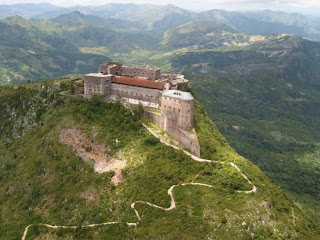The Citadelle Laferrière or, Citadelle Henry Christophe, is a large mountaintop fortress in northern Haiti, approximately 17 miles (27 km) south of the city of Cap-Haïtien and five miles (8 km) uphill from the town of Milot. It is the largest fortress in the Americas and was designated by the United Nations Educational, Scientific and Cultural Organization (UNESCO) as a World Heritage Site in 1982—along with the nearby Sans-Souci Palace. The mountaintop fortress has itself become an icon of Haiti.
The Citadel was built by Henri Christophe, a key leader during the Haitian slave rebellion, after Haiti gained independence from France at the beginning of the 19th century. The massive stone structure was built by up to 20,000 workers between 1805 and 1820 as part of a system of fortifications designed to keep the newly-independent nation of Haiti safe from French incursions. The Citadel was built several miles inland, and atop the 3,000 ft (910 m) Bonnet a L’Eveque mountain, to deter attacks and to provide a lookout into the nearby valleys. Cap-Haïtien and the adjoining Atlantic Ocean are visible from the roof of the fortress. Anecdotally, it is possible to sight the eastern coast of Cuba, some 90 miles (140 km) to the west, on clear days.
The Citadel was built by Henri Christophe, a key leader during the Haitian slave rebellion, after Haiti gained independence from France at the beginning of the 19th century. The massive stone structure was built by up to 20,000 workers between 1805 and 1820 as part of a system of fortifications designed to keep the newly-independent nation of Haiti safe from French incursions. The Citadel was built several miles inland, and atop the 3,000 ft (910 m) Bonnet a L’Eveque mountain, to deter attacks and to provide a lookout into the nearby valleys. Cap-Haïtien and the adjoining Atlantic Ocean are visible from the roof of the fortress. Anecdotally, it is possible to sight the eastern coast of Cuba, some 90 miles (140 km) to the west, on clear days.
Henri Christophe initially commissioned the fortress in 1805. At the time, Christophe was a general in the Haitian army and chief administrator of the country's northern regions. In 1806, along with co-conspirator Alexandre Pétion, Christophe launched a coup against Haiti's emperor, Jean-Jacques Dessalines. Dessalines's death led to a power struggle between Christophe and Pétion, which ended with Haiti divided into northern and southern states, with the north under Christophe's presidency by 1807. He declared himself king in 1811.
The Citadel was part of a system of fortifications that included Fort Jacques and Fort Alexandre, built on the mountains overlooking Port-au-Prince. Dessalines ordered those forts built in 1805 to protect the new nation against French attacks. In the event of an invasion, Christophe planned to have his military burn the valuable crops and food stocks along the coast, then retreat to the fortress, setting ambushes along the sole mountain path leading to the Citadel.
Christophe suffered a stroke in 1820, and some of his troops mutinied. Shortly afterwards, he committed suicide, according to legend, by shooting himself with a silver bullet. Loyal followers covered his body in quicklime and entombed it in one of the Citadel's interior courtyards to prevent others from mutilating the corpse.
The colossal physical dimensions of the fortress have made it into a Haitian national symbol, featured on tourist ministry posters as well as currency and stamps.
The walls of the fortress itself rise up 130 feet (40 m) from the mountaintop, and the entire complex, including cannonball stocks, yet excluding the surrounding grounds, covers an area of 108,000 square feet (10,000 m2).
The large foundation stones of the fortress were laid directly into the stone of the mountaintop and fastened with a mortar mixture that included quicklime, molasses, and the blood of local cows and goats.
The walls of the fortress itself rise up 130 feet (40 m) from the mountaintop, and the entire complex, including cannonball stocks, yet excluding the surrounding grounds, covers an area of 108,000 square feet (10,000 m2).
The large foundation stones of the fortress were laid directly into the stone of the mountaintop and fastened with a mortar mixture that included quicklime, molasses, and the blood of local cows and goats.
Most of the interior of the Citadel fortress itself is accessible to visitors, who may also climb the numerous staircases to the fortress's roof, which is free of guardrails. On a clear day, the city of Cap Haitien and the Atlantic Ocean can be seen to the north.
Though the turbulent political situation in Haiti (principally in the central region) has deterred visitors in recent years, the regions of the north and south of the country remain largely peaceful, making travel to the Citadel less challenging or hazardous than travel within the Haitian capital, Port-au-Prince.
Travelling to Haïti?
Make Unlimited calls to US & Canada while in Haïti
for as little as $5.00 a day.
with





